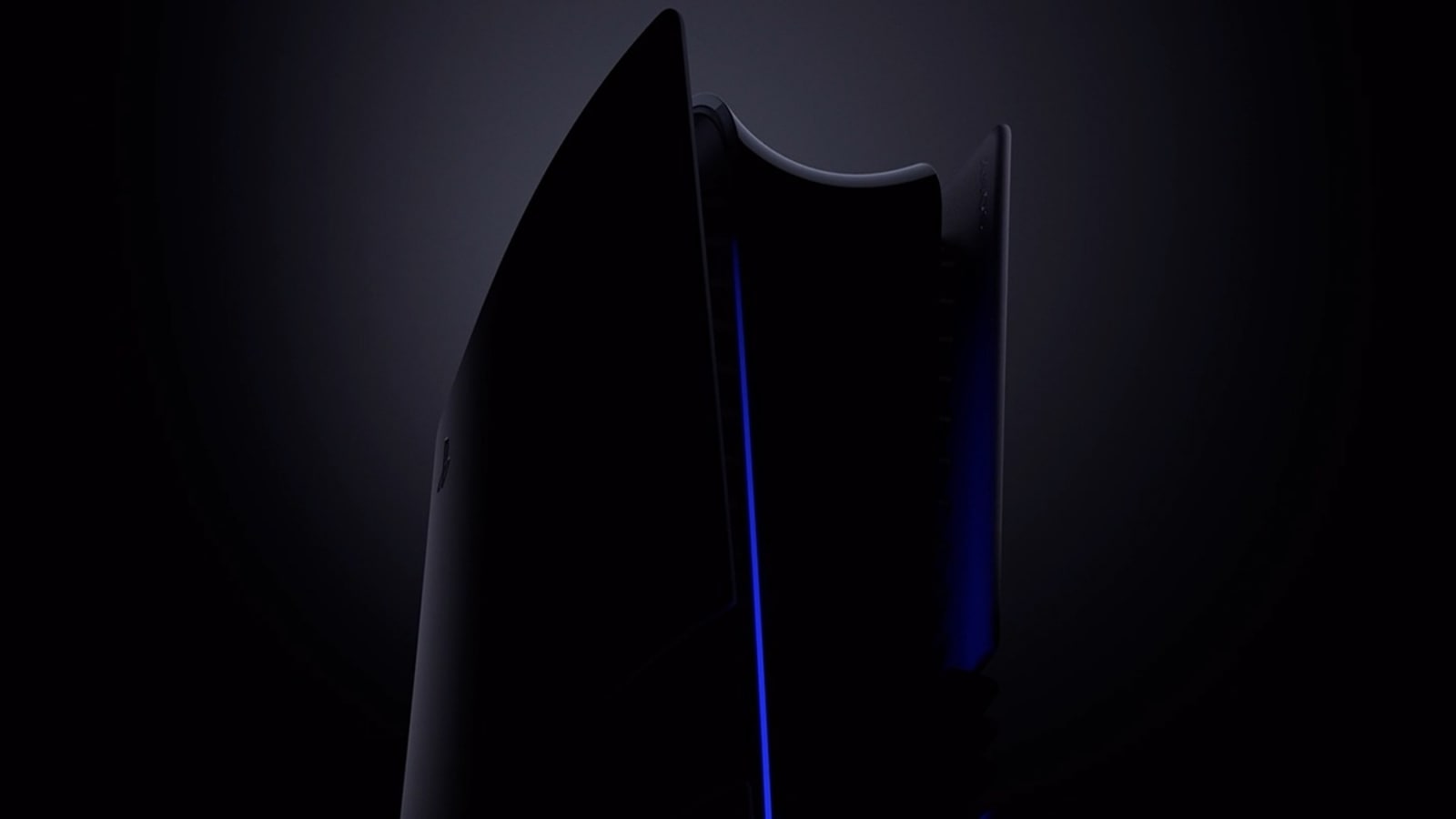Verdict
A genius idea that’s executed well, the Sony HT-AX7 will improve your small screen home cinema experiences thanks to its immersive surround sound speakers. It’s an imperfect speaker and works better with some content than others, but it is a blast to use.
Pros
- Immersive surround sound
- Easy to use
- Long battery life
- Smart design
Cons
- Battery life depletes in standby mode
- Sounds strained at high volumes
- Less convincing with music
- No Wi-Fi
Introduction
When it comes to home cinema sound, the focus has always been on the biggest screen in the house – your TV – but what if you could get a similar performance for your laptop or tablet? If that’s something you’ve wanted, the Sony HT-AX7 is here to fill that void.
The sound from laptops, Macs, smartphones, and tablets is, by and large, disappointing. Like TVs, the designs are thinner and built-in audio systems have become compromised.
The Sony HT-AX7 seeks to tip the scales back in the favour of ‘good sound’, except unlike a home cinema system, you could cart this speaker from one room to another. It’s a rather genius idea. Sony could be on to a winner with the HT-AX7.
Design
- Minimalist aesthetics
- Easy enough to transport
- Detachable speakers
The Sony HT-AX7 is a unique-looking speaker that can be summed up as so: a base unit that holds the battery and main speaker with two detachable speakers up top.
You can place these speakers behind you or around the room you’re in, and the speakers re-attach to the main unit magnetically. It’s not the most secure attachment as it’s easy to accidentally turn the speaker on by brushing past and nudging the speakers.
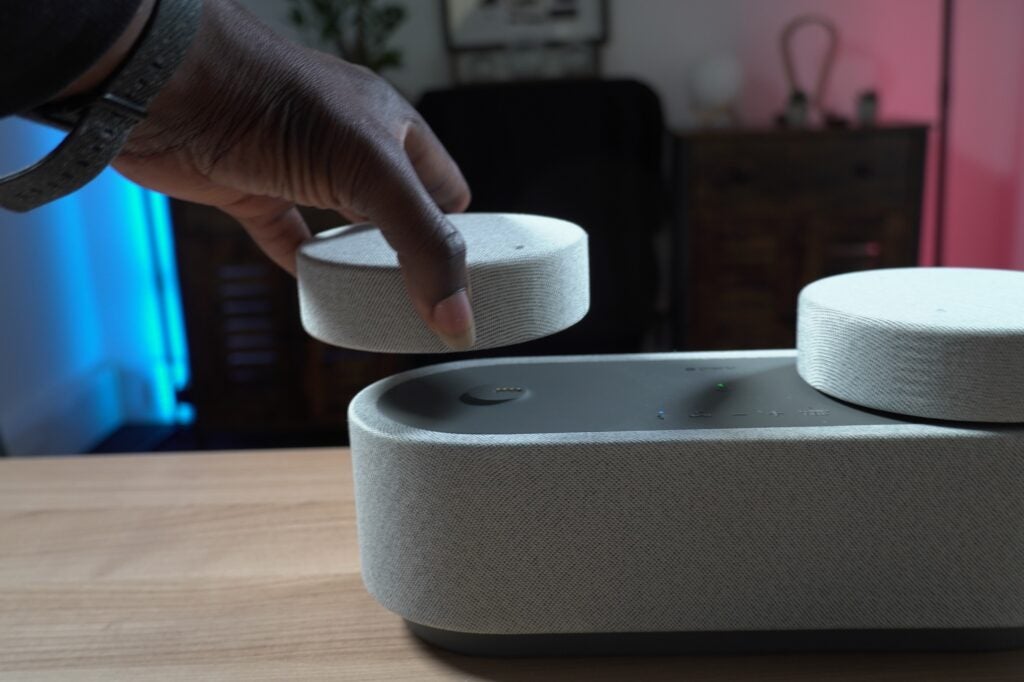
The speaker comes in one finish, an anonymous grey fabric that’s nice to touch, and gives the impression that the speaker could covertly blend into any environment. I found it easy to transport despite its 2kg weight. A one-handed grip is all I needed to shift it from room to room.
On the top surface are buttons for Bluetooth pairing, playback, volume and activating the Sound Field (more on that later). Smack bang in the middle is the power button, and above that is a small LED that gives a clue about current battery levels; flashing orange when battery levels are low, or green when it’s high/charging. It’s visible from a distance or sitting down mainly because of how bright it stands out against the grey finish.
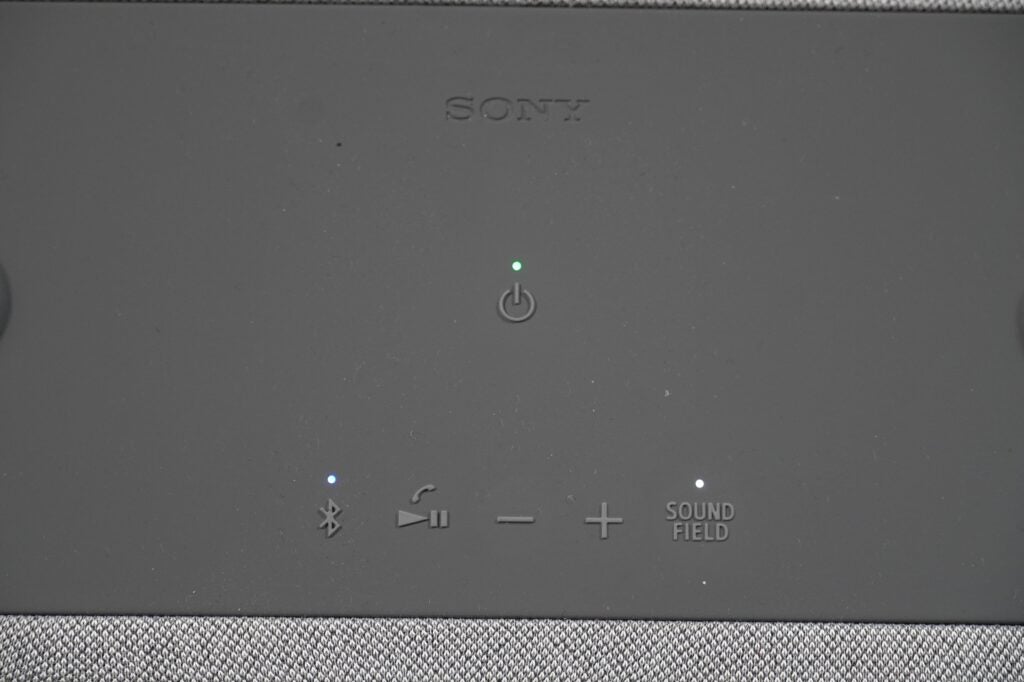
The width of the speaker’s base makes it easy to plant it on any surface, and around the rear is a USB port for charging. That’s the only physical connection, which I’d say is fine given the flexibility and range of Bluetooth. This is not a speaker you’ll be connecting to a TV anyway.
On a sustainable note, the main body is made from recycled plastics, and the fabric material consists of 100% recycled PET bottles. The packaging is also plastic-free due to its use of Sony’s Original Blended Material (made of bamboo, sugarcane, and recycled paper). Every little helps in protecting the environment.
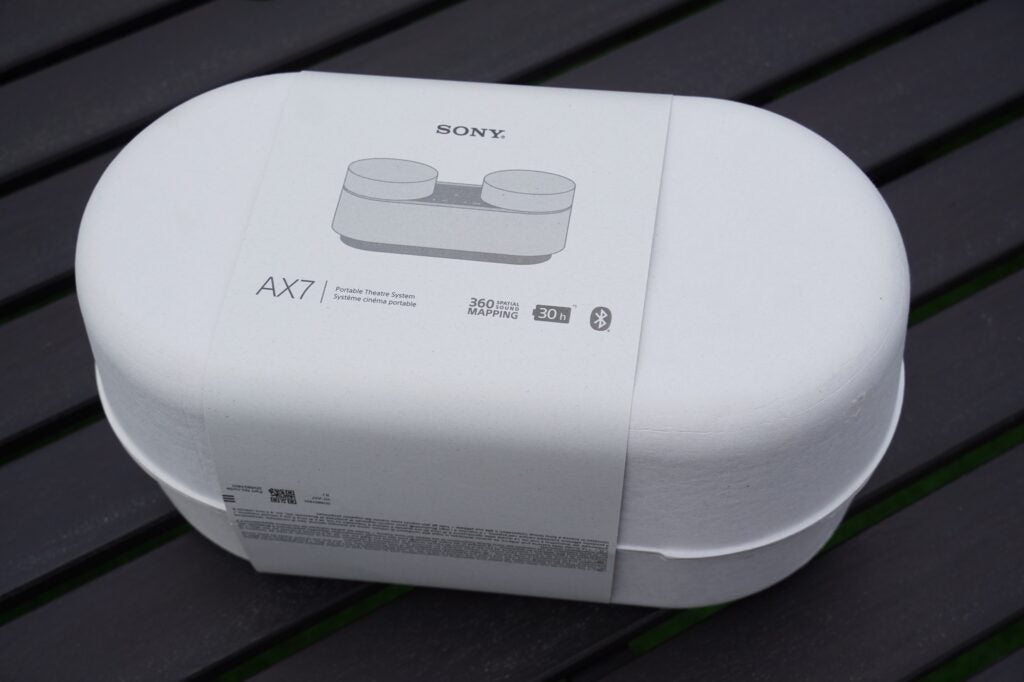
Features
- 360 Spatial Sound Mapping support
- Excellent Bluetooth performance
- 30 hours battery life
Sony’s 360 Spatial Sound Mapping claims it can envelop the listener in spatial sound by creating multiple phantom speakers in front, behind, and above. It can also take stereo sound and make it three-dimensional. This is only available when the speakers are detached and Sound Field is on, but when connected to the main body, the Sound Field function is automatically disabled.
The Sony HT-AX7 connects through a Bluetooth 5.2 connection (SBC and AAC). Bluetooth multipoint is available, although Wi-Fi isn’t supported, and that feels like an oversight for a speaker of this type (and expense). Being able to cast directly over streaming via Bluetooth seems like the type of convenience and accessibility the HT-AX7 is chasing.
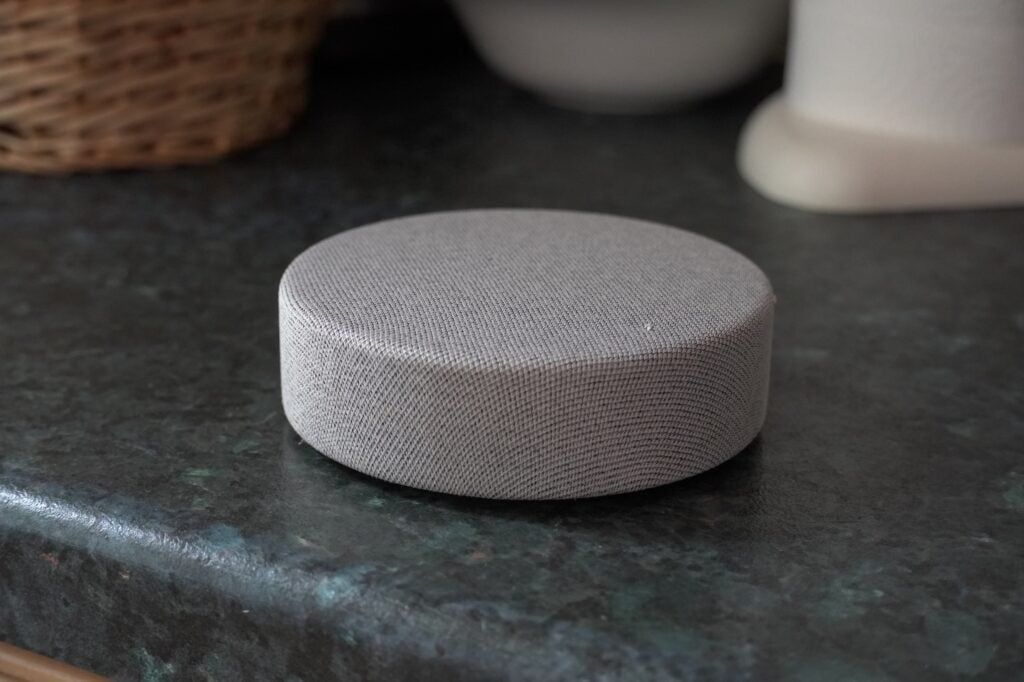
That said, the stability of the Bluetooth connection has been fantastic over testing, able to stretch to 30m. I can’t recall a single dropout in the considerable hours I’ve used this speaker. I’ve placed one detachable speaker in another adjoining room and the signal hasn’t faltered. I’ve placed both speakers in different rooms and they’ve carried on. I’ve even taken a speaker upstairs and left the rest downstairs – no issue in terms of the signal wavering.
Before you get any ideas of a multi-room setup, when out of Sound Field mode, the rear speakers essentially reinforce the sound of the main unit only at a lower volume. These speakers are best when close to one other.
Sony states that battery life is thirty hours, though that’s a figure I’ve found hard to test in a real-world setting. Watching a two-hour film at a volume of 33 and all three modules were still 100%, but my feeling is that’s not the best gauge of its battery performance.
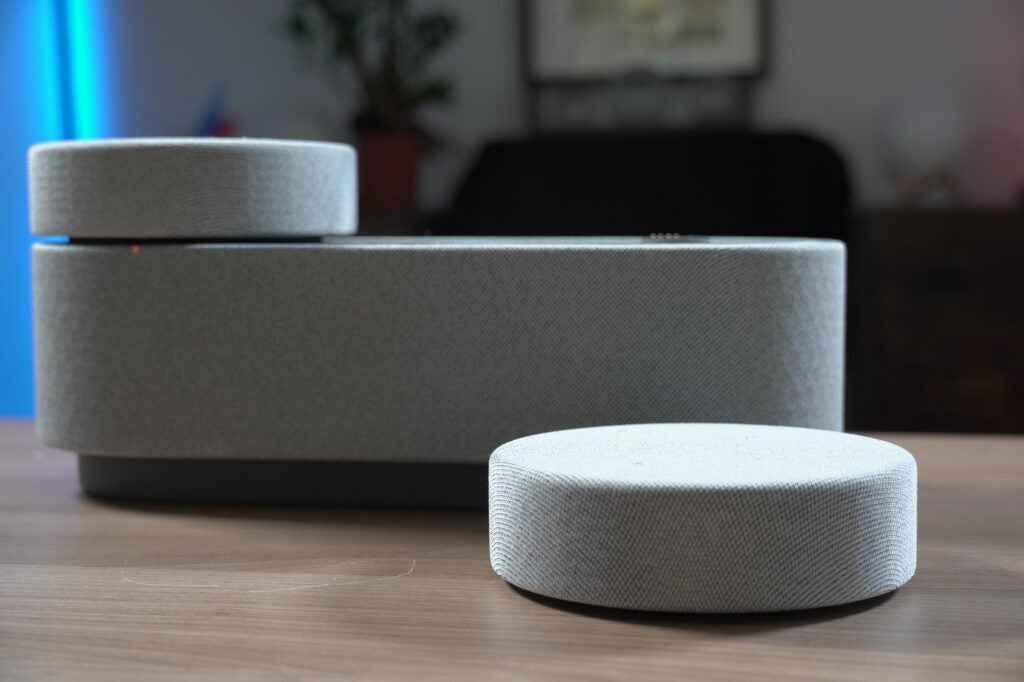
The battery is in the main unit, while the detachable speakers are rechargeable. I’ve found that, when the speakers are placed back on the speaker, the main unit will charge them and deplete its own battery in the process. I’ve regularly encountered situations where the rears are 100% but I’m getting low battery warnings from the main speaker that’s fallen below 20%.
I’ve found that it usually takes around two weeks for the speaker to reach low battery, but also that the AX7’s standby mode seems to fritter battery life away. I’ve left it alone almost fully-charged for a week-and-a-half only to come back and find the main speaker at 20%. The question is whether the HT-AX7 actually turns off and if it does I haven’t figured out how.
That said, there’s fast-charging support – 10 minutes is good enough for another 2.5 hours, and I’ve found replenishing the main speaker is faster than the laborious four hours Sony claims. When plugged into the wall it took just 90 minutes to fully recharge.
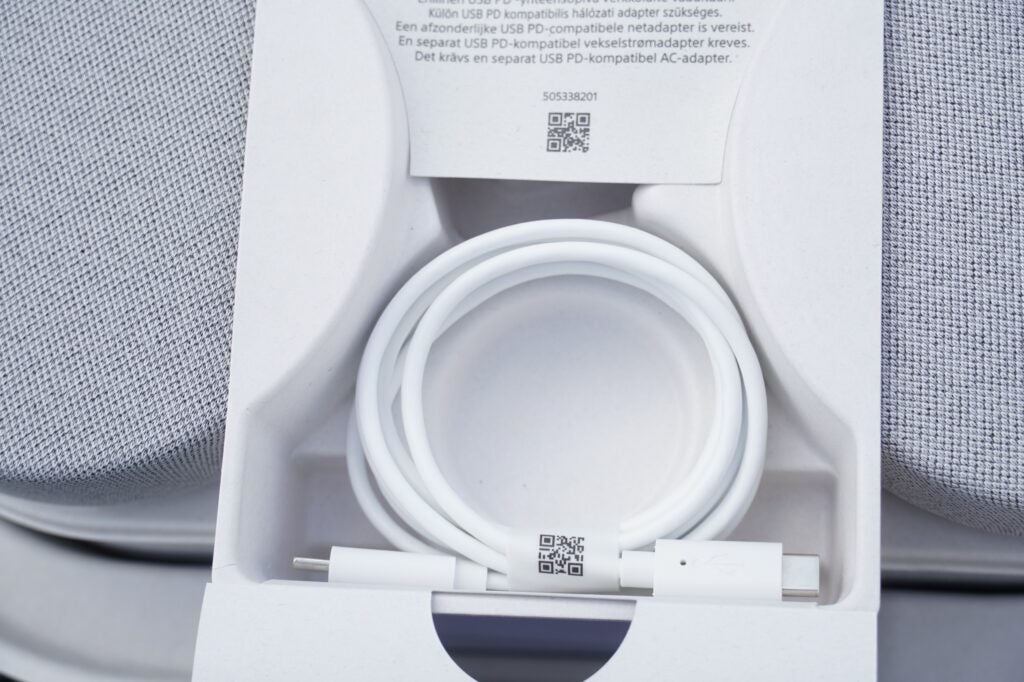
Sony offers a USB-C cable in the packaging but no wall charger. I used my OnePlus and Apple USB-C wall chargers and found neither did the trick (I suspect it’s a voltage issue). However, a Samsung USB-C charger for my work laptop did work. It’s a little annoying that Sony doesn’t go full hog and include a wall adapter, which is probably why the recharge figures are so long.
Before you get started, it’s worth downloading the Sony Home Entertainment Connect app (Android, iOS) that guides the user through initial set-up. Through it, you can customise the rear speaker and bass levels, adjust the volume, enable Night, Voice, and Sound Field modes, control playback, see what quality Bluetooth you’re streaming at, and put the speaker in standby. It’s a wholly simple and straightforward app to use.
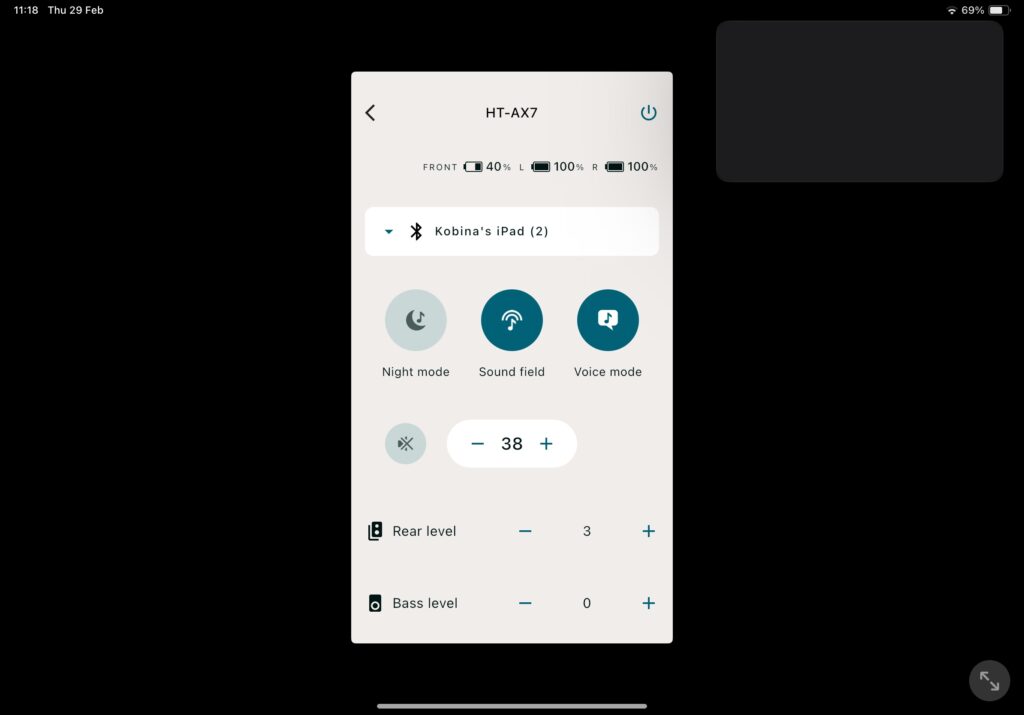
Performance
- Impressive surround sound
- Sounds compressed at higher volumes
- Better balance with films/TV than music
In terms of offering portable surround sound, the Sony HT-AX7 hits the mark. I tend to put my iPad Pro in front of the speaker, but this obscures the main unit, causing a muffled sound. A little distance between the main unit and the screen is recommended.
Initially, it didn’t feel as if sound was coming from the iPad, but from the speaker, but after a few minutes it all came together and I found myself immersed with what was on screen. The rear speakers do a very good job of filling in the space behind, so though the main speaker takes the focus, there’s enough information and activity in the rear to convincingly create a surround sound experience.
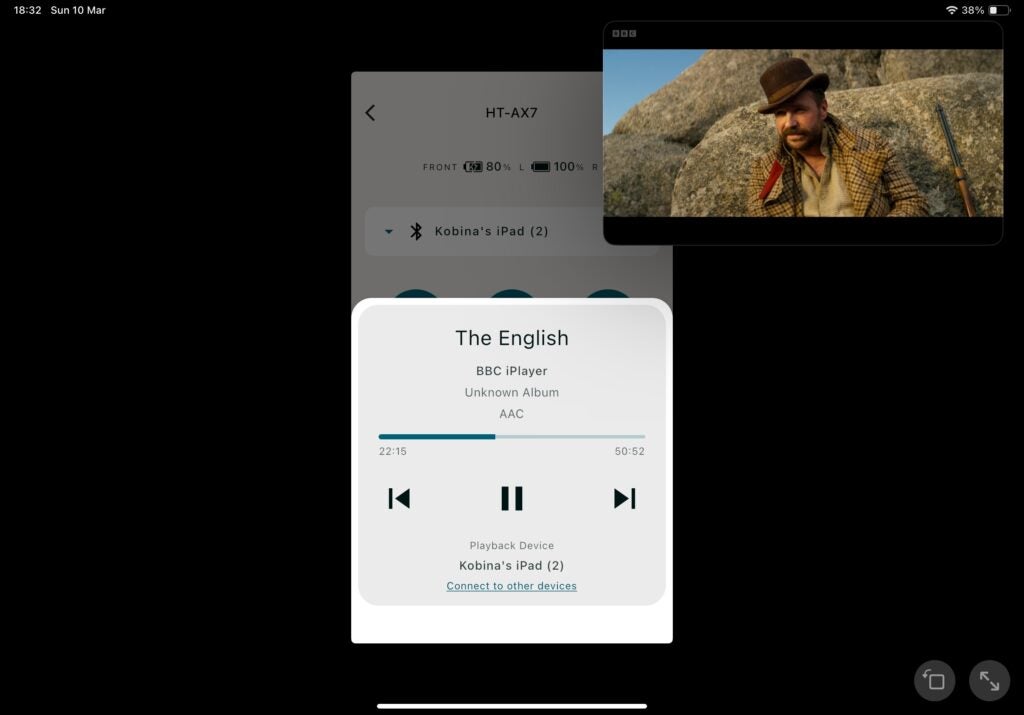
Syncing between the speaker and the screen is excellent, and the closer my iPad is to the speaker the more attached dialogue and audio effects felt to the screen. There is genuine panning of effects in the disc battles of Tron Legacy (Disney+), while in the first episode of The English (iPlayer) the echo of a gunshot reverberates from the screen to the rears.
There’s plenty of enjoyment to be had in the ambience that the rear speakers offer. I can hear small details and background effects that wouldn’t be as prominent if the audio was funnelled through my iPad Pro’s built-in audio system.
Dynamism is fluently conveyed, whether capturing the inflection in voices or music in suspenseful scenes, which aids immersion. At times it really does feel like your own personal movie night.
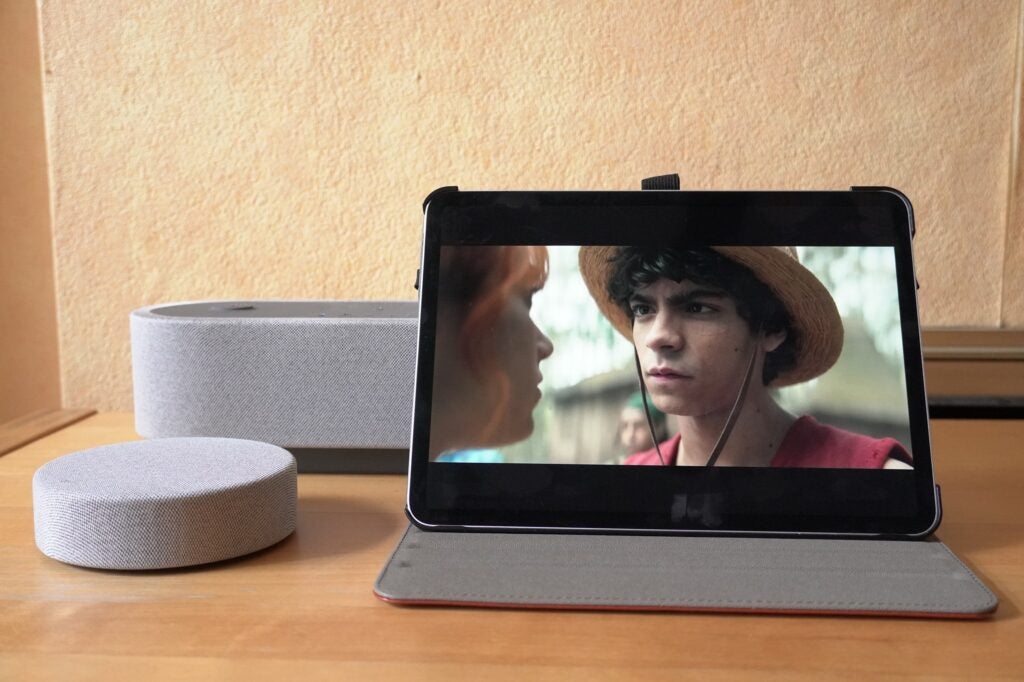
The overhead aspect of these speakers is overstated, with no sense of height that I can sense. You can probably fit two people within the distance of the rear speakers depending on the size of screen you have. Night mode makes sound retreat inwards to the speaker rather than being projected out.
There’s decent bass response with TV shows and films, with a nice depth to the bass in the Daft Punk soundtrack when the sirens get Sam ready for the disc battles, as well as a degree of low-end presence whenever the ‘Voice’ is used in Dune (Netflix). I’ve found the AX7’s bass isn’t always as strong with music, with the low frequencies in Kingdom’s Bank Head merely ok even with the bass level adjusted to ‘MAX’.
Tonally, reproduction of dialogue is warm and on the fuzzy side at default settings, but switch to Voice Mode and it cleans up dialogue better – I can hear Lady Jessica’s recitation of the Litany of Fear well without having to strain – while detaching the speakers draws out more sharpness and clarity. That said, there were times where I felt dialogue was a bit lost in some action scenes in Mr and Mrs Smith (Prime Video).
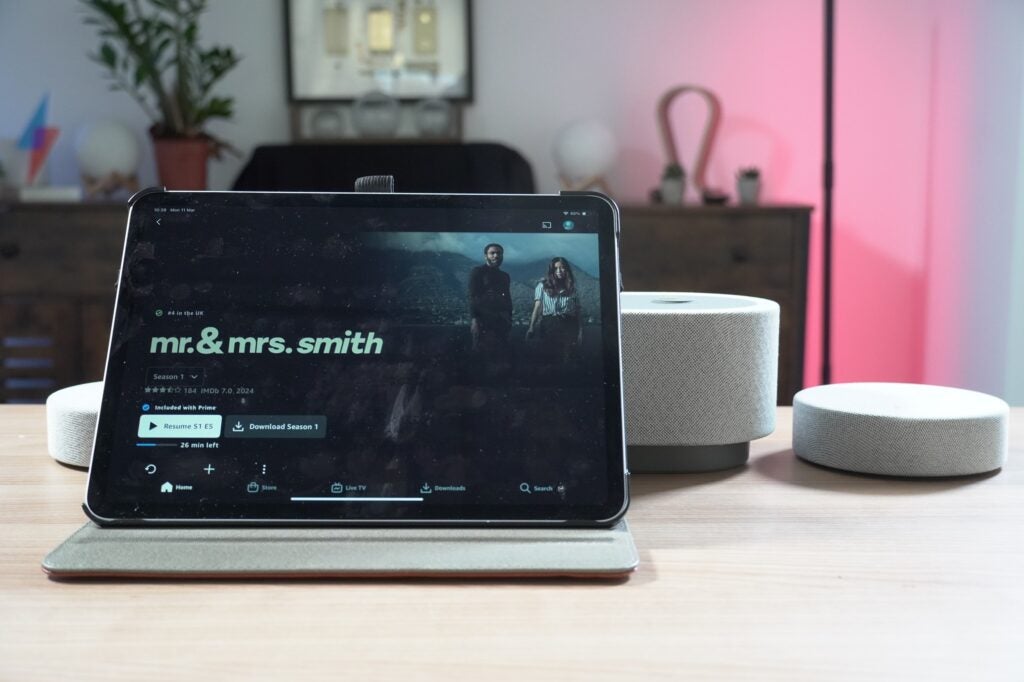
At higher volumes dialogue can sound thin and strained with the speakers detached, and in this configuration the speaker exhibits a lean tone that strips it of detail. I’d say volume 35 is the highest you’ll want to go.
Most of what I’ve stated applies to music. There are fine levels of clarity applied to vocals, though in Sound Field mode they retreat to sounding thin in Benjamin Clementine’s London. Turn that mode off and you’ll get a more natural performance with the speaker’s natural warmth and smoothness taking over, though the speaker loses out in terms of clarity and definition. There’s a trade-off, and neither mode brings out the best in music.
It won’t serve up massive amounts of bass, but what’s provided is fair enough in light of the speaker’s two passive radiators. Rhythmically, it can deliver fast-paced songs like GoGo Penguin’s Raven with drive, while there’s an enjoyable energy to the percussion in boygenius’ $20.
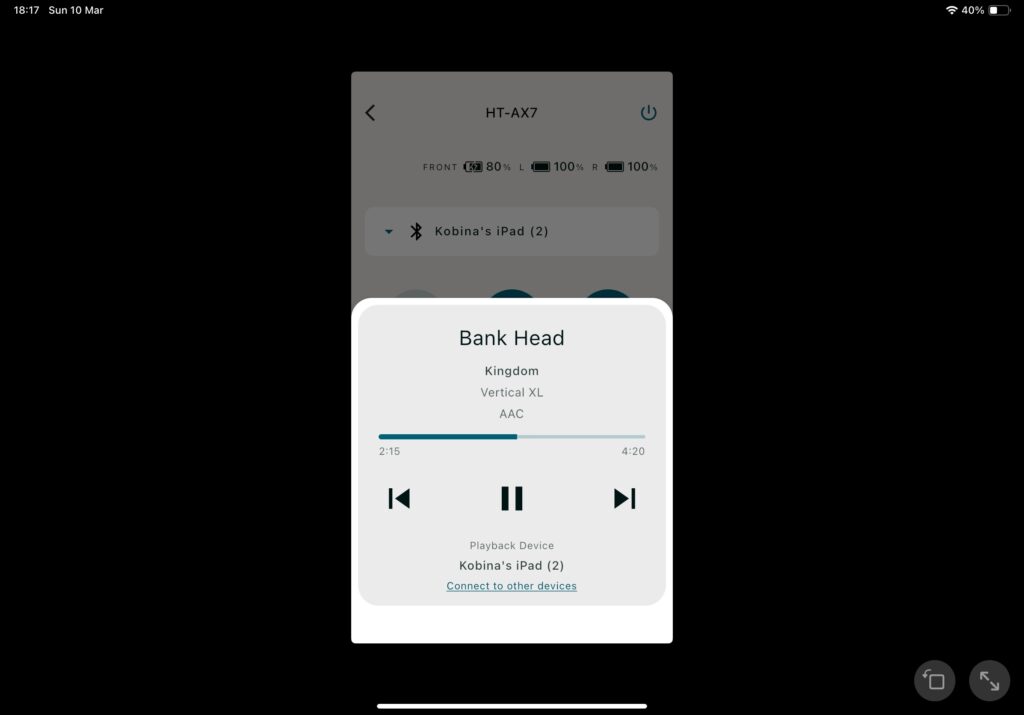
The top end shows decent levels of clarity, variation, and detail, though you’ll never mistake the AX7 for being bright – in fact, its treble performance is rather dull. Regardless, it’s a decent music system, though not necessarily its forte.
One last qualm I have with the Sony HT-AX7 is specifically about whether it sounds better with the Sound Field mode on or off. With 5.1 content – Dune or Mr and Mrs Smith – having the Sound Field brings benefits, evening out the front and rear speakers and spreading sounds better.
With other content, let’s say YouTube or podcasts, what I hear in the rears is similar to the front speaker so activating Sound Field seemed pointless. If audio sounds compressed, deactivating Sound Field mode makes dialogue smoother which is a decent compromise.
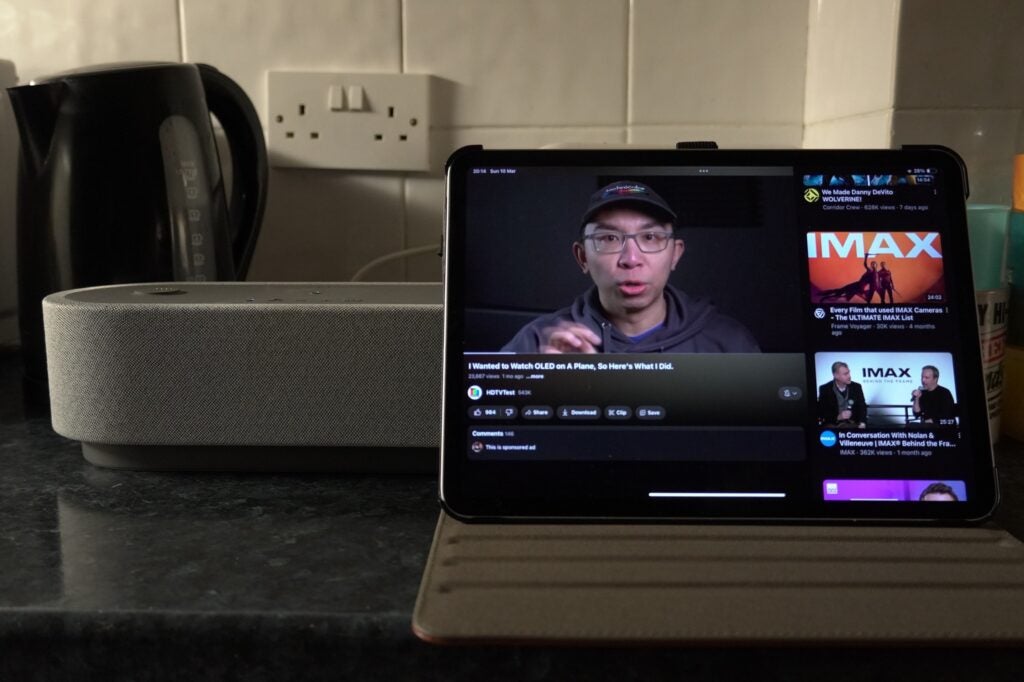
Latest deals
Should you buy it?
If you want better sound from your mobile device
Laptops, smartphones, tablets; whatever small screen you have is going to be compromised when it comes to audio. The Sony HT-AX7 fleshes out sound in a manner that makes for your own personal surround sound experience.
If the expense makes you raise your eyebrows
£449 is a lot to spend on what’s essentially a portable wireless speaker. It makes more sense for those who don’t even have a TV and use mobile devices religiously, but will they be able to afford the HT-AX7? I’m less certain of that.
Final Thoughts
In the time I’ve spent with the Sony HT-AX7, I’ve had a blast. It lives up to the promise of creating your own personal space for movies and TV shows. It’s far and away better than listening to video/audio content through the tinny speakers on your mobile device or laptop.
Its design is smart and allows for sound to be spread throughout a room, and its ease of use is a strength. While battery life is long, the fact that it depletes when in standby mode means it’ll require regular charging. Other reservations are that it sounds compressed at higher volumes, and that the Sound Field mode sounds better with content that has the information required (films and TV series) but doesn’t always sound great with some YouTube or music content.
Expense is another factor to consider. At nearly £449, that’s more than Sony’s own WH-1000XM5 and more than Bose’s QuietComfort Ultra Headphones (which feature Bose’s Immersive Audio feature). The positive of the Sony is that it opens the soundstage in a way that a headphone can’t.
The Sony HT-AX7 is a surround system that puts the emphasis on being ‘personal’, and in that regard it is a success. Ultimately its performance could be improved, but this is the first speaker of its ilk that I’ve come across, and hopefully not the last. For more traditional options, check out our Best Surround Sound System guide.
How we test
We test every wireless speaker system we review thoroughly over an extended period of time. We use industry standard tests to compare features properly. We’ll always tell you what we find. We never, ever, accept money to review a product.
Find out more about how we test in our ethics policy.
FAQs
There is no Dolby Atmos support on this speaker, though it can offer three-dimensionalised stereo sound.
Verdict
A genius idea that’s executed well, the Sony HT-AX7 will improve your small screen home cinema experiences thanks to its immersive surround sound speakers. It’s an imperfect speaker and works better with some content than others, but it is a blast to use.
Pros
- Immersive surround sound
- Easy to use
- Long battery life
- Smart design
Cons
- Battery life depletes in standby mode
- Sounds strained at high volumes
- Less convincing with music
- No Wi-Fi
Introduction
When it comes to home cinema sound, the focus has always been on the biggest screen in the house – your TV – but what if you could get a similar performance for your laptop or tablet? If that’s something you’ve wanted, the Sony HT-AX7 is here to fill that void.
The sound from laptops, Macs, smartphones, and tablets is, by and large, disappointing. Like TVs, the designs are thinner and built-in audio systems have become compromised.
The Sony HT-AX7 seeks to tip the scales back in the favour of ‘good sound’, except unlike a home cinema system, you could cart this speaker from one room to another. It’s a rather genius idea. Sony could be on to a winner with the HT-AX7.
Design
- Minimalist aesthetics
- Easy enough to transport
- Detachable speakers
The Sony HT-AX7 is a unique-looking speaker that can be summed up as so: a base unit that holds the battery and main speaker with two detachable speakers up top.
You can place these speakers behind you or around the room you’re in, and the speakers re-attach to the main unit magnetically. It’s not the most secure attachment as it’s easy to accidentally turn the speaker on by brushing past and nudging the speakers.

The speaker comes in one finish, an anonymous grey fabric that’s nice to touch, and gives the impression that the speaker could covertly blend into any environment. I found it easy to transport despite its 2kg weight. A one-handed grip is all I needed to shift it from room to room.
On the top surface are buttons for Bluetooth pairing, playback, volume and activating the Sound Field (more on that later). Smack bang in the middle is the power button, and above that is a small LED that gives a clue about current battery levels; flashing orange when battery levels are low, or green when it’s high/charging. It’s visible from a distance or sitting down mainly because of how bright it stands out against the grey finish.

The width of the speaker’s base makes it easy to plant it on any surface, and around the rear is a USB port for charging. That’s the only physical connection, which I’d say is fine given the flexibility and range of Bluetooth. This is not a speaker you’ll be connecting to a TV anyway.
On a sustainable note, the main body is made from recycled plastics, and the fabric material consists of 100% recycled PET bottles. The packaging is also plastic-free due to its use of Sony’s Original Blended Material (made of bamboo, sugarcane, and recycled paper). Every little helps in protecting the environment.

Features
- 360 Spatial Sound Mapping support
- Excellent Bluetooth performance
- 30 hours battery life
Sony’s 360 Spatial Sound Mapping claims it can envelop the listener in spatial sound by creating multiple phantom speakers in front, behind, and above. It can also take stereo sound and make it three-dimensional. This is only available when the speakers are detached and Sound Field is on, but when connected to the main body, the Sound Field function is automatically disabled.
The Sony HT-AX7 connects through a Bluetooth 5.2 connection (SBC and AAC). Bluetooth multipoint is available, although Wi-Fi isn’t supported, and that feels like an oversight for a speaker of this type (and expense). Being able to cast directly over streaming via Bluetooth seems like the type of convenience and accessibility the HT-AX7 is chasing.

That said, the stability of the Bluetooth connection has been fantastic over testing, able to stretch to 30m. I can’t recall a single dropout in the considerable hours I’ve used this speaker. I’ve placed one detachable speaker in another adjoining room and the signal hasn’t faltered. I’ve placed both speakers in different rooms and they’ve carried on. I’ve even taken a speaker upstairs and left the rest downstairs – no issue in terms of the signal wavering.
Before you get any ideas of a multi-room setup, when out of Sound Field mode, the rear speakers essentially reinforce the sound of the main unit only at a lower volume. These speakers are best when close to one other.
Sony states that battery life is thirty hours, though that’s a figure I’ve found hard to test in a real-world setting. Watching a two-hour film at a volume of 33 and all three modules were still 100%, but my feeling is that’s not the best gauge of its battery performance.

The battery is in the main unit, while the detachable speakers are rechargeable. I’ve found that, when the speakers are placed back on the speaker, the main unit will charge them and deplete its own battery in the process. I’ve regularly encountered situations where the rears are 100% but I’m getting low battery warnings from the main speaker that’s fallen below 20%.
I’ve found that it usually takes around two weeks for the speaker to reach low battery, but also that the AX7’s standby mode seems to fritter battery life away. I’ve left it alone almost fully-charged for a week-and-a-half only to come back and find the main speaker at 20%. The question is whether the HT-AX7 actually turns off and if it does I haven’t figured out how.
That said, there’s fast-charging support – 10 minutes is good enough for another 2.5 hours, and I’ve found replenishing the main speaker is faster than the laborious four hours Sony claims. When plugged into the wall it took just 90 minutes to fully recharge.

Sony offers a USB-C cable in the packaging but no wall charger. I used my OnePlus and Apple USB-C wall chargers and found neither did the trick (I suspect it’s a voltage issue). However, a Samsung USB-C charger for my work laptop did work. It’s a little annoying that Sony doesn’t go full hog and include a wall adapter, which is probably why the recharge figures are so long.
Before you get started, it’s worth downloading the Sony Home Entertainment Connect app (Android, iOS) that guides the user through initial set-up. Through it, you can customise the rear speaker and bass levels, adjust the volume, enable Night, Voice, and Sound Field modes, control playback, see what quality Bluetooth you’re streaming at, and put the speaker in standby. It’s a wholly simple and straightforward app to use.

Performance
- Impressive surround sound
- Sounds compressed at higher volumes
- Better balance with films/TV than music
In terms of offering portable surround sound, the Sony HT-AX7 hits the mark. I tend to put my iPad Pro in front of the speaker, but this obscures the main unit, causing a muffled sound. A little distance between the main unit and the screen is recommended.
Initially, it didn’t feel as if sound was coming from the iPad, but from the speaker, but after a few minutes it all came together and I found myself immersed with what was on screen. The rear speakers do a very good job of filling in the space behind, so though the main speaker takes the focus, there’s enough information and activity in the rear to convincingly create a surround sound experience.

Syncing between the speaker and the screen is excellent, and the closer my iPad is to the speaker the more attached dialogue and audio effects felt to the screen. There is genuine panning of effects in the disc battles of Tron Legacy (Disney+), while in the first episode of The English (iPlayer) the echo of a gunshot reverberates from the screen to the rears.
There’s plenty of enjoyment to be had in the ambience that the rear speakers offer. I can hear small details and background effects that wouldn’t be as prominent if the audio was funnelled through my iPad Pro’s built-in audio system.
Dynamism is fluently conveyed, whether capturing the inflection in voices or music in suspenseful scenes, which aids immersion. At times it really does feel like your own personal movie night.

The overhead aspect of these speakers is overstated, with no sense of height that I can sense. You can probably fit two people within the distance of the rear speakers depending on the size of screen you have. Night mode makes sound retreat inwards to the speaker rather than being projected out.
There’s decent bass response with TV shows and films, with a nice depth to the bass in the Daft Punk soundtrack when the sirens get Sam ready for the disc battles, as well as a degree of low-end presence whenever the ‘Voice’ is used in Dune (Netflix). I’ve found the AX7’s bass isn’t always as strong with music, with the low frequencies in Kingdom’s Bank Head merely ok even with the bass level adjusted to ‘MAX’.
Tonally, reproduction of dialogue is warm and on the fuzzy side at default settings, but switch to Voice Mode and it cleans up dialogue better – I can hear Lady Jessica’s recitation of the Litany of Fear well without having to strain – while detaching the speakers draws out more sharpness and clarity. That said, there were times where I felt dialogue was a bit lost in some action scenes in Mr and Mrs Smith (Prime Video).

At higher volumes dialogue can sound thin and strained with the speakers detached, and in this configuration the speaker exhibits a lean tone that strips it of detail. I’d say volume 35 is the highest you’ll want to go.
Most of what I’ve stated applies to music. There are fine levels of clarity applied to vocals, though in Sound Field mode they retreat to sounding thin in Benjamin Clementine’s London. Turn that mode off and you’ll get a more natural performance with the speaker’s natural warmth and smoothness taking over, though the speaker loses out in terms of clarity and definition. There’s a trade-off, and neither mode brings out the best in music.
It won’t serve up massive amounts of bass, but what’s provided is fair enough in light of the speaker’s two passive radiators. Rhythmically, it can deliver fast-paced songs like GoGo Penguin’s Raven with drive, while there’s an enjoyable energy to the percussion in boygenius’ $20.

The top end shows decent levels of clarity, variation, and detail, though you’ll never mistake the AX7 for being bright – in fact, its treble performance is rather dull. Regardless, it’s a decent music system, though not necessarily its forte.
One last qualm I have with the Sony HT-AX7 is specifically about whether it sounds better with the Sound Field mode on or off. With 5.1 content – Dune or Mr and Mrs Smith – having the Sound Field brings benefits, evening out the front and rear speakers and spreading sounds better.
With other content, let’s say YouTube or podcasts, what I hear in the rears is similar to the front speaker so activating Sound Field seemed pointless. If audio sounds compressed, deactivating Sound Field mode makes dialogue smoother which is a decent compromise.

Latest deals
Should you buy it?
If you want better sound from your mobile device
Laptops, smartphones, tablets; whatever small screen you have is going to be compromised when it comes to audio. The Sony HT-AX7 fleshes out sound in a manner that makes for your own personal surround sound experience.
If the expense makes you raise your eyebrows
£449 is a lot to spend on what’s essentially a portable wireless speaker. It makes more sense for those who don’t even have a TV and use mobile devices religiously, but will they be able to afford the HT-AX7? I’m less certain of that.
Final Thoughts
In the time I’ve spent with the Sony HT-AX7, I’ve had a blast. It lives up to the promise of creating your own personal space for movies and TV shows. It’s far and away better than listening to video/audio content through the tinny speakers on your mobile device or laptop.
Its design is smart and allows for sound to be spread throughout a room, and its ease of use is a strength. While battery life is long, the fact that it depletes when in standby mode means it’ll require regular charging. Other reservations are that it sounds compressed at higher volumes, and that the Sound Field mode sounds better with content that has the information required (films and TV series) but doesn’t always sound great with some YouTube or music content.
Expense is another factor to consider. At nearly £449, that’s more than Sony’s own WH-1000XM5 and more than Bose’s QuietComfort Ultra Headphones (which feature Bose’s Immersive Audio feature). The positive of the Sony is that it opens the soundstage in a way that a headphone can’t.
The Sony HT-AX7 is a surround system that puts the emphasis on being ‘personal’, and in that regard it is a success. Ultimately its performance could be improved, but this is the first speaker of its ilk that I’ve come across, and hopefully not the last. For more traditional options, check out our Best Surround Sound System guide.
How we test
We test every wireless speaker system we review thoroughly over an extended period of time. We use industry standard tests to compare features properly. We’ll always tell you what we find. We never, ever, accept money to review a product.
Find out more about how we test in our ethics policy.
FAQs
There is no Dolby Atmos support on this speaker, though it can offer three-dimensionalised stereo sound.








